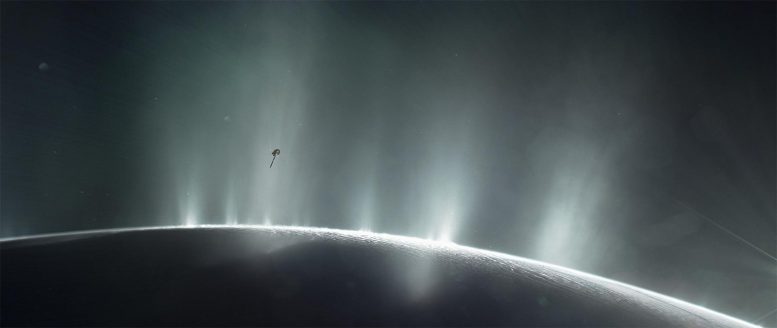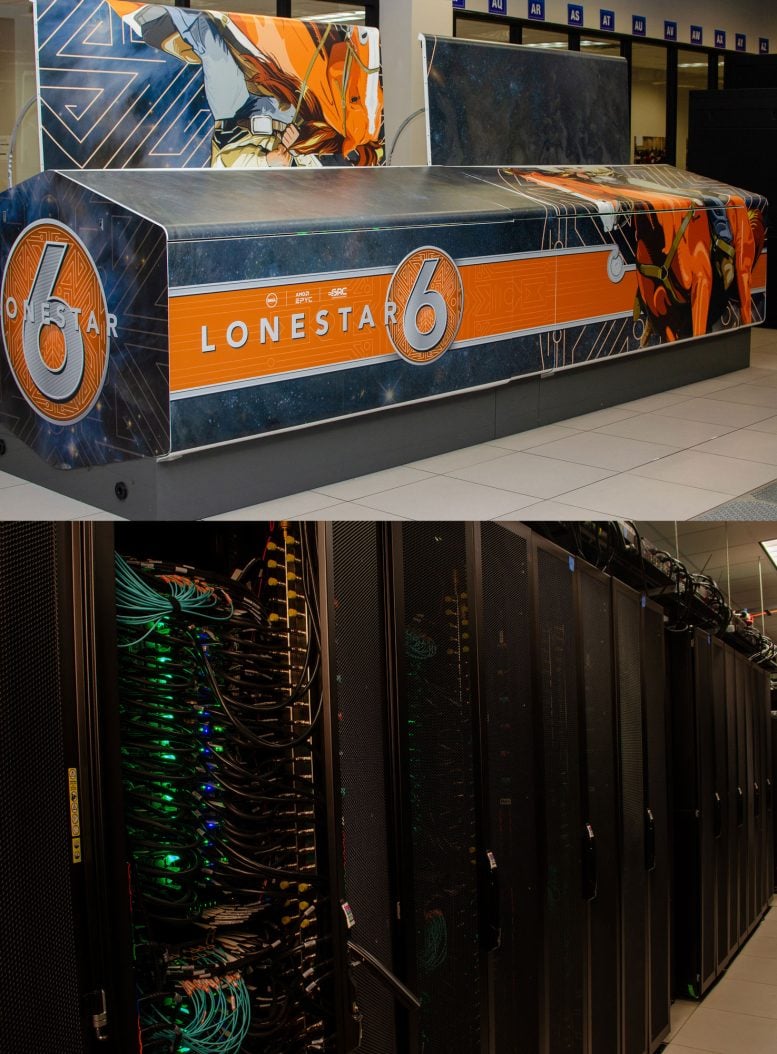
Simulations indicate that Saturn’s moon Enceladus ejects less ice into space than previously estimated.
In the 1600s, astronomers Christiaan Huygens and Giovanni Cassini aimed their telescopes at Saturn and made a groundbreaking discovery. What appeared to be glowing bands around the planet were not solid structures at all, but enormous rings made up of countless smaller arcs.
Hundreds of years later, NASA’s Cassini-Huygens (Cassini) mission carried this exploration to an entirely new level. Beginning in 2005, the spacecraft captured a continuous stream of striking images that reshaped scientific knowledge of Saturn and its moons. One of its most remarkable findings was on Enceladus, a frozen world where immense geysers shoot icy particles into space, creating a faint ring that circles the planet.
Now, researchers at the Texas Advanced Computing Center (TACC) have used Cassini’s data in advanced supercomputer models to refine estimates of how much ice Enceladus ejects into space. These new results are important for understanding the moon’s activity and will also guide future robotic missions that may one day probe its hidden subsurface ocean, a potential habitat for life.
“The mass flow rates from Enceladus are between 20 to 40 percent lower than what you find in the scientific literature,” said Arnaud Mahieux, a senior researcher at the Royal Belgian Institute for Space Aeronomy and an affiliate of the UT Austin Department of Aerospace Engineering & Engineering Mechanics.
Supercomputers to Enceladus
Mahieux is the corresponding author of a computational study of Enceladus recently published in the Journal of Geophysical Research: Planets. In it, he and colleagues developed Direct Simulation Monte Carlo (DSMC) models that improve understanding of the structure and behavior of enormous plumes of water vapor and icy particles ejected by vents on the Enceladus surface.
This study builds on prior work published in 2019 and led by Mahieux that first used DSMC models to derive the initial conditions that create the icy plumes, such as vent size, ratio of water vapor to ice grains, temperature, and the speed of exit.

“DSMC simulations are very expensive,” Mahieux said. “We used TACC supercomputers back in 2015 to obtain the parameterizations to reduce computation time from 48 hours then to just a few milliseconds now.”
Revealing Enceladus’s Secrets
Using mathematical parameterizations, researchers calculated the density and velocity of Enceladus’s cryovolcanic plumes, drawing on data Cassini gathered as it flew directly through them.
“The main finding of our new study is that for 100 cryovolcanic sources, we could constrain the mass flow rates and other parameters that were not derived before, such as the temperature at which the material was exiting. This is a big step forward in understanding what’s happening on Enceladus,” Mahieux said.
Enceladus is a tiny world, just 313 miles across, whose weak gravity cannot hold back the icy jets erupting from its vents. This is properly accounted for in these DSMC models. Earlier approaches were less sophisticated in their physics and gas dynamics than our DSMC model. What Enceladus does is akin to a volcano hurling lava into space—except the ejecta are plumes of water vapor and ice.
The simulations model how gas in the plume moves at the micro level, where particles move, collide, and exchange energy like marbles hitting each other in a game. Several millions of molecules are simulated on microsecond time steps, and the DSMC models allow calculations at a lower, more realistic pressure than before, with longer travel time between collisions.
David Goldstein, UT Austin professor and study co-author, led the development in 2011 of the DSMC code called Planet. TACC awarded Goldstein allocations on the Lonestar6 and Stampede3 supercomputers through The University of Texas Research cyberinfrastructure portal, which supports researchers at all 14 UT system institutions.
“TACC systems have a wonderful architecture that offers a lot of flexibility,” Mahieux said. “If we’re using the DSMC code on just a laptop, we could only simulate tiny domains. Thanks to TACC, we can simulate from the surface of Enceladus up to 10 kilometers of altitude, where the plumes expand into space.”
Icy Moons and Hidden Oceans
Saturn dwells beyond what astronomers call the ‘snow line’ in the solar system, joining other planets with icy moons such as Jupiter, Uranus, and Neptune.
“There is an ocean of liquid water under these ‘big balls of ice,’” Mahieux said. “These are many other worlds, besides the Earth, which have a liquid ocean. The plumes at Enceladus open a window to the underground conditions.”
NASA and the European Space Agency are planning future missions to revisit Enceladus, with ambitions that go far beyond flybys. Proposals include landing on the moon’s surface and drilling through its crust to probe the ocean below, a search for signs of life hidden beneath miles of ice. Understanding and measuring the content of the Enceladus plumes gives us a way of actually measuring what is happening below the surface without drilling through the ice.
“Supercomputers can give us answers to questions we couldn’t dream of asking even 10 or 15 years ago,” Mahieux said. “We can now get much closer to simulating what nature is doing.”
Reference: “Enceladus Water Plume Modeling Using DSMC” by A. Mahieux, D. B. Goldstein, P. L. Varghese, L. M. Trafton, G. Portyankina, L. W. Esposito, M. E. Perry, J. H. Waite, B. S. Southworth and S. Kempf, 29 August 2025, Journal of Geophysical Research: Planets.
DOI: 10.1029/2025JE009008
Never miss a breakthrough: Join the SciTechDaily newsletter.
Follow us on Google, Discover, and News.